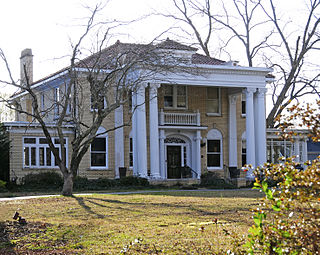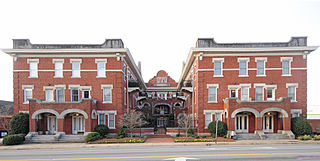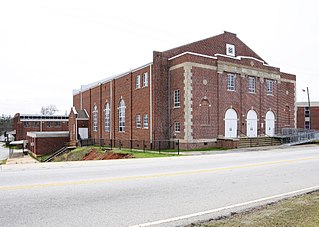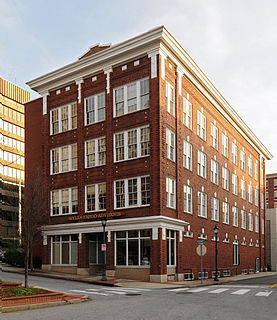
Fountain Inn is a city in Greenville and Laurens counties in the U.S. state of South Carolina. The population was 7,799 at the 2010 census, up from 6,017 in 2000. It is part of the Greenville–Mauldin–Easley Metropolitan Statistical Area.

The Old Market is a neighborhood located in downtown Omaha, Nebraska, United States, and is bordered by South 10th Street to the east, 13th Street to the west, Farnam Street to the north and Jackson Street to the South. The neighborhood has many restaurants, art galleries and upscale shopping. The area retains its brick paved streets from the turn of the 20th century, horse-drawn carriages, and covered sidewalks in some areas. It is not uncommon to see a variety of street performers, artists, and other vendors.

Earle Town House is a historic house in Greenville, South Carolina. It was listed in the National Register of Historic Places on August 5, 1969, and is included in the Col. Elias Earle Historic District.

The Lanneau-Norwood House is a historic, late 19th-century house on Belmont Avenue in Greenville, South Carolina. The house is an outstanding example of Second Empire architecture in the American South and is one of the last surviving Victorian-era homes in Greenville. The property was added to the National Register of Historic Places in 1982.

C. Granville Wyche House is a historic home located at Greenville, South Carolina. It was built in 1931, and consists of a two-story, five bay central blocked flanked by one-story balconied projections. It is of blond brick in the Italian Renaissance style with a low-pitched tile roof, wide eaves with brackets, and full-length, first floor windows. It features a massive portico with grouped classical columns and pilasters. Also on the property is a small grotto and an unpainted barn dating from the mid-1930s.

Davenport Apartments is a historic apartment building located at Greenville, South Carolina. It was built in 1915–1916, and is a three-story, "U"-shaped, brick building. It consists of a large rectangular section in the rear with two smaller wings that extend from the rear block to the street. The front façade features two one-story porches with stone elliptical arches and brick pillars.

American Cigar Factory, also known as Stone Manufacturing Company, is a historic factory building located at Greenville, South Carolina. It was built about 1902, and is a four-story, rectangular brick building with segmental arch openings. It has a low-pitched gable roof with a projecting eave and floors supported by wooden posts.

Greenville Gas and Electric Light Company, also known as Duke Power Steam Plant, is a historic power plant located at Greenville, South Carolina. The two brick vernacular Victorian style buildings were built about 1890. The larger building served as a coal-fueled, steam-powered electric generating plant, and is a one-story, rectangular building with round arched window and door openings. The second building is a two-story rectangular building originally used as offices for the power company. They were originally owned and operated by the Greenville Gas and Electric Light and Power Company, then sold in 1910, to a company that later evolved into Duke Power Company.

Working Benevolent Temple and Professional Building is a historic office building located at Greenville, South Carolina. It was built in 1922, and is a three-story, steel frame brick building. The building housed offices for African-American doctors, lawyers, dentists, a newspaper, and insurance firms and housed the first black mortuary in Greenville. The temple was also the center for Greenville's civil rights activities during the 1960s.

Imperial Hotel, also known as Hotel Greenville, is a historic hotel building located at Greenville, South Carolina. It was built in 1911–1912, and is a seven-story, U-shaped skyscraper with a buff-colored brick veneer over a steel frame. It was originally a 90-room hotel, and expanded by 1930 to 250 rooms. The hotel closed in the early 1970s, but this establishment is still used as a nursing home for disabled people 55 and over. An adjacent parking garage was demolished in the 1980s.

Greenville County Courthouse, also known as Greenville Family Courts Building, is a historic courthouse located at Greenville, South Carolina. It was built in 1918, and is a Beaux-Arts style brick and concrete building with terra cotta trim. The building consists of a three-story front section, with an eight-story tower behind. The building served as the courthouse for Greenville County until 1950 when the court was moved to a new building. The Family Court of Greenville County was located then in the building and remained there until 1991.

Parker High School Auditorium is a historic high school auditorium located at Greenville, South Carolina. It was built in 1938 with funding provided by the Works Progress Administration. It is a Classical Revival style 7500 square foot rectangular brick building with a front gabled roof. It is the last remaining building from the largest WPA school project in South Carolina.

Carolina Supply Company is a historic commercial building located at Greenville, South Carolina. It was built in 1914, and is a four-story, brick building in a utilitarian Renaissance Revival style. The building housed a textile and industrial supply company that supplied mills with equipment and supplies. The building now houses Wells Fargo Bank.

Gilfillin and Houston Building also known as Greenville Bakery and Greenville Auto Sales, is a historic commercial building located at Greenville, South Carolina. It was built in 1915, and is a two-story, brick commercial block. The building's façade is organized into two storefront sections and features a curvilinear brick gable and parapet embellished with a central, circular, limestone-keyed and brick-surrounded cartouche containing the letters "G" and "H" intertwined.
Brushy Creek, also known as Vardry McBee House and Alexander McBee House, is a historic home located at Greenville, South Carolina. It was built about 1836 as a 1+1⁄2-story, frame farmhouse. In 1924, the house was expanded with the addition of a one-story frame room, that incorporated the formerly separate kitchen into the house itself. Further renovations were made in 1938–1939 and 1951. Also on the property are a log barn, a brick shed, a well house, and the ruins of a grist mill. It was the home of Vardry McBee (1775–1864), prominent 19th-century businessman, entrepreneur, and delegate to the Secession Convention of Greenville District known as the “Father of Greenville,” and his son Alexander McBee (1822–1897), prominent 19th-century businessman, banker, and state representative of Greenville District.

Hampton–Pinckney Historic District is a national historic district located at Greenville, South Carolina. It encompasses 70 contributing buildings in a residential section of Greenville. The houses date from about 1890 to 1930, and include Italianate, Greek Revival, Queen Anne, various bungalows, and examples of Gothic Revival and Colonial Revival design, as well as vernacular forms. The oldest house in the district is the McBee House.

West End Commercial Historic District is a national historic district located at Greenville, South Carolina. It encompasses 15 contributing buildings in Greenville's second "downtown." The commercial buildings primarily date from about 1880 to 1920, and include examples of Victorian commercial architecture. Notable buildings include the American Bank, Alliance and Mills & McBayer Cotton Warehouses, Indian River Fruit Store, Pete's Place, Bacot's West End Drug Store/Stringer's Drug, Furman Lunch, and Greer Thompson Building.

E. W. Montgomery Cotton Warehouse, also known as the Greenville Bonded Cotton Warehouse and now the Elements West Apartments, is a historic cotton warehouse located in Greenville, South Carolina. The original section was built about 1928. Following the property's purchase in 1933 by Edmund Warren Montgomery, a significant cotton merchant and broker in upstate South Carolina from the early-to-mid-20th century, three additions were completed. The two-story, brick building measures 553 feet long and 60 feet deep, and has 68,000 square feet in seven bays.

The Greenville Elks Lodge is a historic commercial and fraternal club building at 18 East North Street in Greenville, South Carolina. It is a rectangular four-story building, finished in brick and stone. The main entrance is a particularly distinguished example of transitional Art Deco/Moderne styling, with fluted details in the stone work, and a transom with Art Deco diamond patterning. It was built in 1949 to a design by William Riddle Ward, a prominent local architect. It is the only known work in this style by Ward, who was better known for revival style designs, and is one of Greenville's only Art Deco designs. The building was occupied by Greenville Elks Lodge 858 until 1991.

The Old Beth Israel Synagogue is a historic religious building at 307 Townes Street in the Stone Avenue neighborhood of Greenville, South Carolina. It is a single-story Classical Revival brick building with stone trim. This first Orthodox Jewish synagogue in Greenville was designed by Joseph Cunningham, a local architect, and built in 1929-30 for a congregation founded in 1910. The congregation moved to a larger space in 1957.
























